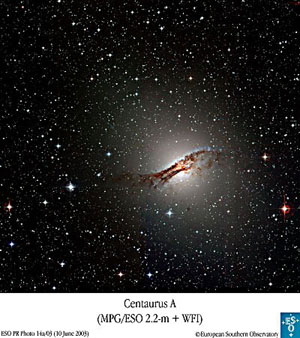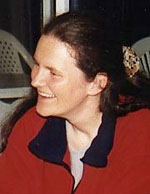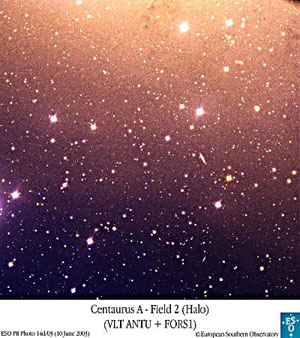There are myriad unknown objects in the vast oceans of space, many of which we may never understand. However, an international team of astronomers has recently discovered more than 1000 luminous red variable stars in one of our neighbouring elliptical galaxies, Centaurus A in the constellation of The Centaur. This first-ever census of variable Mira-type marvellous stars in a galaxy outside our Local Group could help astronomers understand the role played by such massive objects in the evolution of giant elliptical galaxies.
Centaurus A (NGC 5128) is the nearest giant galaxy, a mere 13 million light-years from earth. It is outside the so-called Local Group of Galaxies in which the Milky Way sails. This elliptical galaxy is peculiar in that it has recently accreted one of its companion galaxies, making it something of astronomical spectacle. At the centre of the galaxy is a super massive black hole, which makes it a strong source of radiowaves and X-rays.

Centaurus A, a peculiar elliptical galaxy with a 1000 marvellous stars
ESO astronomer Marina Rejkuba and her colleagues David Silva, Sydney University’s Tim Bedding and Dante Minniti scanned two regions of Centaurus A in their search for unusual stars. They made very accurate measurements over a three-year period of the brightness changes and periods of these stars and found that they are mostly cool long-period variable stars of the so-called ‘Mira-type’. The observed variability is caused by stellar pulsation.
The ESO team would normally have to make repeated trips to a telescope to investigate unusual star systems in this way, however, the operational system of the VLT at the ESO Paranal Observatory in Chile is configured to allow such long-term research programs to be carried out. Between April 1999 and July 2002, the 8.2 metre VLT ANTU telescope on Cerro Paranal was repeatedly operated in service mode and images of the two fields in Centaurus A were recorded in the near-infrared region of the electromagnetic spectrum. Each field was observed more than twenty times over the three-year period. And, at times the measurements were made during times of exceptional seeing, i.e. there were clear skies and little turbulence to distort the light from distant stars as they pass through the earth’s atmosphere. The numerous recordings were combined to allow the astronomers to find their Mira-type stars.

Marina Rejkuba
A pre-analysis process was carried out to identify each point in every image captured by the telescope, then the DAOPHOT software was used to the brightness of each point of light recorded. While most stars in these fields were as expected of constant brightness, more than 1000 stars displayed variations in their brightness over time; this is by far the largest number of variable stars ever discovered in a galaxy outside the Local Group of Galaxies.

David Silva
We are really very fortunate to have carried out this ambitious project so successfully, says Rejkuba. She points out that the observations and their ongoing evaluation confirm the presence of an intermediate-age population of stars in the halo of this nearby galaxy and opens a new window towards studies of the stellar constituents of elliptical galaxies. The researchers will make available their star catalogue through the European research journal Astronomy & Astrophysics.

The photo shows numerous stars in a small field in the galaxy Centaurus A – many of the red ones have been shown to be of the Mira-type

Tim Bedding (right) with the business end of a telescope that can measure the fluctuations in brightness of stars. Colleague Tony Monger is also pictured
Further reading
Astronomy Astrophysics. Marina Rejkuba, David Silva, Tim Bedding, and Dante Minniti
http://arxiv.org/abs/astro-ph/0305432
Centaurus A
http://www.star.le.ac.uk/edu/Elliptical.shtml
Local Group
http://www.seds.org/messier/more/local.html
Marina Rejkuba
http://www.eso.org/~mrejkuba/
David Silva
http://www.eso.org/~dsilva/
Tim Bedding
http://www.physics.usyd.edu.au/~bedding/
DAPHOT software
http://www.starlink.rl.ac.uk/star/docs/sun42.htx/sun42.html
Suggested searches
Variable stars
Elliptical galaxies